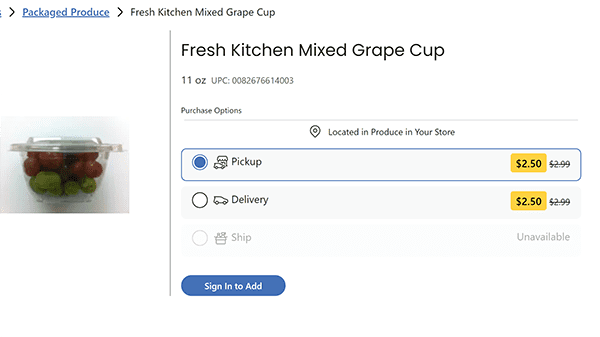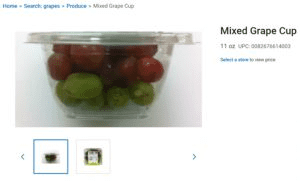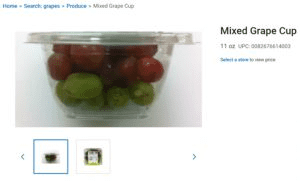
A year ago, I wrote a column about online store checks.
It was prompted by a talk I presented at the Association of Table Grape Growers of Mexico about e-commerce and grapes—something that wasn’t a huge category of grocery at the time.
I asked growers how many of them had “store checked” in person – meaning, do they look at their product/commodity at stores when they travel. Hands went up in every corner of the room.
Then I asked if anyone had done the same thing online? Very few, if any, raised their hand.
Now, with online grocery experiencing near-exponential growth, it’s time to bring this up again. The topic was brought up during the Produce Marketing Association’s Virtual Town Hall on April 22, as well.
How does your product look online?
A year ago, I checked dozens of grocers’ online platforms. Most of it was not encouraging. I checked again…and found the same problems.
1.Does your product look good?
This seems like a no-brainer to me. Last year, I found this listing on Kroger’s online ordering portal. I said it looks like a food safety advisory.

Unfortunately, the listing is still live – with the same photo.
Across the retailers I checked in this column’s update, I found inconsistencies in photography for product listings, even within the same category.
I’m going to pick on Kroger again. I pick on the big guys because they have the biggest targets on their back.
The avocado listings several different styles of photo for essentially the same product. Why? And why use this badly-lit junky looking avocado? I’m all for showing produce as it typically looks — not airbrushed perfection — but these just don’t look good.
 Why don’t we use an image of our produce displays as they look at the store? A virtual produce department would be amazing, though complicated to execute. You could even do it as an illustrated planogram instead of actual photography. Ok, I’m going off the rails here but wouldn’t that be a great way to encourage impulse shopping?
Why don’t we use an image of our produce displays as they look at the store? A virtual produce department would be amazing, though complicated to execute. You could even do it as an illustrated planogram instead of actual photography. Ok, I’m going off the rails here but wouldn’t that be a great way to encourage impulse shopping?
How difficult would it be to have a photographer go into a store and shoot an image of every display for the e-commerce team to use as the beauty art, instead of random stock images that don’t have a consistent (or appealing) look?
2. Are retailers even using your brand?
Last year, I found most retailers weren’t promoting produce brands. This year, I found a few more branded images, but mostly own brands, like Kroger bagged avocados or citrus.
Last year, the only brand listing I found was at Whole Foods, for Holiday Seedless Grapes.
This year, Whole Foods wins again with branded produce with a listing for The Grapery’s Cotton Candy Seedless Grapes.

Which brought me to Problem 3.
3. Even if it is your brand in the picture, the website often isn’t updated when a promotion is over.
Those Holiday grapes? Those were listed in March, and that particular grape is available only in the winter.
The Grapery’s Cotton Candy Seedless Grapes listed this year aren’t the same brand as what’s available currently in the market.
What’s going to happen if a brand-loyal consumer is substituted with something they weren’t expecting, like a standard red grape instead of a Holiday?
This is a major growing pain for online grocery. The Wall Street Journal delved into nonsense substitutions by shoppers, like celery for celery root, and what these problems are costing retailers in both dollars and repeat online sales.
Trusting a shopper to pick your produce is the No. 1 barrier to online fresh produce expansion, according to the Power of Produce.
People are pretty forgiving right now when it comes to online order fulfillment. My neighborhood’s Buy Nothing group is flooded with posts like “My Instacart Order had 4 pounds of bananas instead of 4 bananas, anybody want some?” and “My grocery order had X and I ordered Y, and they just told me to keep it. Does anybody want it?”
They won’t be forgiving forever. These issues have to be resolved if retailers want to keep those online shoppers.
And if we want to continue to grow fresh produce sales online, we have to have a better online presence than this:

A year ago, I wrote a column about online store checks.
It was prompted by a talk I presented at the Association of Table Grape Growers of Mexico about e-commerce and grapes—something that wasn’t a huge category of grocery at the time.
I asked growers how many of them had “store checked” in person – meaning, do they look at their product/commodity at stores when they travel. Hands went up in every corner of the room.
Then I asked if anyone had done the same thing online? Very few, if any, raised their hand.
Now, with online grocery experiencing near-exponential growth, it’s time to bring this up again. The topic was brought up during the Produce Marketing Association’s Virtual Town Hall on April 22, as well.
How does your product look online?
A year ago, I checked dozens of grocers’ online platforms. Most of it was not encouraging. I checked again…and found the same problems.
1.Does your product look good?
This seems like a no-brainer to me. Last year, I found this listing on Kroger’s online ordering portal. I said it looks like a food safety advisory.

Unfortunately, the listing is still live – with the same photo.
Across the retailers I checked in this column’s update, I found inconsistencies in photography for product listings, even within the same category.
I’m going to pick on Kroger again. I pick on the big guys because they have the biggest targets on their back.
The avocado listings several different styles of photo for essentially the same product. Why? And why use this badly-lit junky looking avocado? I’m all for showing produce as it typically looks — not airbrushed perfection — but these just don’t look good.
 Why don’t we use an image of our produce displays as they look at the store? A virtual produce department would be amazing, though complicated to execute. You could even do it as an illustrated planogram instead of actual photography. Ok, I’m going off the rails here but wouldn’t that be a great way to encourage impulse shopping?
Why don’t we use an image of our produce displays as they look at the store? A virtual produce department would be amazing, though complicated to execute. You could even do it as an illustrated planogram instead of actual photography. Ok, I’m going off the rails here but wouldn’t that be a great way to encourage impulse shopping?
How difficult would it be to have a photographer go into a store and shoot an image of every display for the e-commerce team to use as the beauty art, instead of random stock images that don’t have a consistent (or appealing) look?
2. Are retailers even using your brand?
Last year, I found most retailers weren’t promoting produce brands. This year, I found a few more branded images, but mostly own brands, like Kroger bagged avocados or citrus.
Last year, the only brand listing I found was at Whole Foods, for Holiday Seedless Grapes.
This year, Whole Foods wins again with branded produce with a listing for The Grapery’s Cotton Candy Seedless Grapes.

Which brought me to Problem 3.
3. Even if it is your brand in the picture, the website often isn’t updated when a promotion is over.
Those Holiday grapes? Those were listed in March, and that particular grape is available only in the winter.
The Grapery’s Cotton Candy Seedless Grapes listed this year aren’t the same brand as what’s available currently in the market.
What’s going to happen if a brand-loyal consumer is substituted with something they weren’t expecting, like a standard red grape instead of a Holiday?
This is a major growing pain for online grocery. The Wall Street Journal delved into nonsense substitutions by shoppers, like celery for celery root, and what these problems are costing retailers in both dollars and repeat online sales.
Trusting a shopper to pick your produce is the No. 1 barrier to online fresh produce expansion, according to the Power of Produce.
People are pretty forgiving right now when it comes to online order fulfillment. My neighborhood’s Buy Nothing group is flooded with posts like “My Instacart Order had 4 pounds of bananas instead of 4 bananas, anybody want some?” and “My grocery order had X and I ordered Y, and they just told me to keep it. Does anybody want it?”
They won’t be forgiving forever. These issues have to be resolved if retailers want to keep those online shoppers.
And if we want to continue to grow fresh produce sales online, we have to have a better online presence than this:

Pamela Riemenschneider is the Retail Editor for Blue Book Services

 Why don’t we use an image of our produce displays as they look at the store? A virtual produce department would be amazing, though complicated to execute. You could even do it as an illustrated planogram instead of actual photography. Ok, I’m going off the rails here but wouldn’t that be a great way to encourage impulse shopping?
Why don’t we use an image of our produce displays as they look at the store? A virtual produce department would be amazing, though complicated to execute. You could even do it as an illustrated planogram instead of actual photography. Ok, I’m going off the rails here but wouldn’t that be a great way to encourage impulse shopping?




